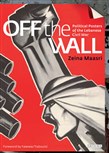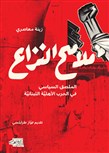Sinno on Maasri, 'Off the Wall: Political Posters of the Lebanese Civil War'
Author: Zeina Maasri Reviewer: Nadine Sinno
Zeina Maasri. Off the Wall: Political Posters of the Lebanese Civil War. London: I. B. Tauris, 2008. Illustrations. 168 pp. $33.00 (paper), ISBN 978-1-84511-951-5.
Reviewed by Nadine Sinno (Virginia Tech)
Published on H-Levant (May, 2016)
Commissioned by Ghenwa Hayek
What does it take to create an effective political poster, particularly in times of war and political upheaval? What can one learn about war through a seemingly insignificant and transient artifact, such as the political poster? How do artists utilize their skills to advance the ideologies of the political party with whom they are affiliated? And, most important, how can we better appreciate the complexity of political posters in a way that transcends the traditional propaganda/activism paradigm? In Off the Wall: Political Posters of the Lebanese Civil War, Zeina Maasri seeks to answer these questions and more. The book offers a comparative analysis of the political posters that filled Lebanon's streets during the Lebanese civil war (1975-90).
The preface elucidates Maasri's rationale for embarking on this exhaustive study. Concerned by the general lack of critical attention to Beirut's wartime visual culture, with the exception of a single study of graffiti by Maria Chakhtoura (La guerre des graffiti, Liban 1975-1978 [1978]), and confronted by the difficulty of tracking down wartime political posters, Maasri tasked herself with excavating, collecting, and analyzing these important documents lest they vanish, unexamined. After all, wartime political posters were at risk of disappearing as a result of foreign invasions, neglect, and destruction at the hands of saboteurs or even private collectors who feared that their poster collections would expose their political affinities and/or activities, rendering them vulnerable to retaliation. By preserving these posters and telling their stories, Maasri has added her voice to other fiction writers, filmmakers, and journalists who have refused to put a lid on Lebanon's traumatic past by engaging with the disturbing events of the civil war. Furthermore, the recent publication of books dedicated to the analysis of the visual cultures of the Middle East-which include such books as Mia Gröndahl's Gaza Graffiti: Messages of Love and Politics (2009), Lina Khatib's Image Politics in the Middle East: The Role of the Visual in Political Struggle (2012), and Mikala Hyldig Dal's Cairo: Images of Transition (2014)-affirm the importance of examining the visual cultures of the Arab world, particularly during times of conflict and political change, when the streets are transformed into sites of struggle.
In her introduction, and throughout the book, Maasri persuasively argues for shifting the discourse on political posters from one that focuses on propaganda-which is often associated with state power, coercion, and audience passivity-to one that focuses on encoding/decoding, discursivity, articulation, and hegemony (or rather multiple hegemonies). For Maasri, given the context of the Lebanese civil war, in which multiple political factions vehemently competed to assert their own versions of the "truth," propaganda does not offer a productive interpretive tool. Aside from its failure to underscore the cacophony of political currents characterizing the civil war, this precarious term, she argues, has often been used to connote the manipulation of audiences, thus overlooking the agentic role that civilians play in the construction of meaning. Drawing on studies by Stuart Hall, Ernesto Laclau, Chantal Mouffe, and Michel Foucault, Maasri reconceptualizes political posters as "symbolic sites of hegemonic struggle" and asserts that they discursively articulate "the discourses, desires, fears and collective imaginaries pertinent to various political identities formed and transformed during wartime" (pp. 15, 17).
The first chapter explores the production process and the aesthetics of the political poster. The chapter demonstrates how each faction's media officials commissioned artists who were sympathetic to the party's ideologies in the design of posters. These unofficial "copywriters," who generally possessed a deep knowledge of the party's history and its political rhetoric, directed painters, political cartoonists, and book illustrators to depict the faction's slogans and struggles visually, and they tasked a press that was also ideologically aligned with the faction's politics with printing the posters. The chapter also delves into the various artistic influences that shaped the "encoding" of diverse political posters. Those influences include common prewar visual practices, such as modern painting, billboards for popular films, and calligraphy. The posters also benefitted from inspirations and collaborations beyond Lebanon. Hizbullah's posters, as she demonstrates, were influenced by the Iranian political-religious poster, while the posters of the Lebanese left-wing and Arab nationalist factions were informed by the aesthetic genres of the Palestinian resistance as well as anti-imperialist, transnational networks. The aesthetics of each poster were also influenced by shifting sociopolitical and material conditions. For instance, as the civil war intensified, the production of icons of political leadership became more crucial, thus leading to the increased commissioning of painters to produce portraits of sectarian political leaders, or what is referred to as the "zu'ama," in Lebanese dialect. By the same token, as political factions became increasingly preoccupied with securing military gains, the aesthetic quality of posters suffered a decline.
The second part of the book includes four chapters that examine the interrelated topics of leadership, commemoration, martyrdom, and belonging. The leadership chapter demonstrates the crucial role that posters played in amplifying prominent wartime leaders, such as Druze leader Kamal Jumblatt, Maronite leader Bashir Gemayel, and Shiite leader Musa al-Sadr, whose tragic deaths (or disappearance in al-Sadr's case) devastated their communities. Yet the role of such posters went beyond the act of glorification: incorporating the leaders' most memorable quotations, achievements, and/or their highly stylized images, the leadership posters served to boost the morale of combatants, ignite the passions of supporters, and even ensure the continuity of the bereaved communities. Ubiquitous posters, such as those of a pensive-looking Jumblatt, a heroic Gemayel, and an enigmatic al-Sadr, emphasized the stubborn presence-not absence-of these leaders, as they "looked over" their respective neighborhoods, providing their supporters with spiritual guidance.
Commemoration posters were utilized to mark and interpret significant occasions, such as the birth or death of party founders, events specific to the party, and relevant regional developments. The commemorative posters were influential in offering their "hegemonic articulations" of political events, as they described and shaped wartime discourse, thus "join[ing] the battle over meaning and history" (p. 72). For example, April 13, 1975, the day that marks the official start of the Lebanese civil war, is commemorated differently by different parties. April 13 is referred to as "the dawn of freedom" in one of the posters issued by the Lebanese Forces; the poster exalts the work of its youthful combatants and articulates an ethos of "awakening" and "revelation." However, the same date is commemorated in a poster by the Arab Liberation Front (a faction of the Palestine Liberation Organization, PLO) as a day that evokes the 1948 Deir Yassin massacre. The poster highlights the victimization of Palestinians at the hands of both the Kataeb and the Zionists and symbolically yokes the two groups by connecting their acts of violence against civilians.
Martyrdom also occupied a strong presence in the political posters of the Lebanese civil war. As militarized parties fought vehemently on the streets, they took pride in "proclaiming the amount of martyrs they had 'offered' up to the common cause of the front" (p. 87). The martyr posters served as "public obituaries" that adorned the martyrs' neighborhoods and often included the martyrs' personal pictures and quotes, as well as "rich visual and textual rhetoric" that celebrated the martyr for advancing the party's specific cause. For example, Hizbullah's martyr posters often included references to Imam Hussein's "exemplary jihad" (p. 98). The posters of martyrs served the double role of paying tribute to the dead fighters and appealing to prospective fighters who encountered the martyrs' posters on the street. The last chapter explores the use of the political poster as a tool of "normalizing a friend-versus-enemy antagonism" (p. 101). Here, the reader witnesses the ways in which the posters sought to visually dehumanize the "Other" and instill fear and paranoia against the party's enemy. Conversely, iconography of tradition, heritage, folklore, and others were utilized to assert communal belonging and resistance. The collective imaginary constructed around the south of Lebanon, for example, is represented by several posters that employ symbolic imagery to assert an inalienable connection between people and their (occupied) land.
Maasri's book successfully illuminates the multilayered discourses, subjectivities, and aesthetic genres that coalesce in the political poster of wartime Lebanon. Nonetheless, a more thorough exploration of the process of "decoding"/consumption, or an engagement with reader reception, would have certainly enriched the text. In all fairness, Maasri is aware of the book's limitation in this area, and she explains that "the decoding moment, in the form of direct audience response to the poster message, cannot be the subject of study in this book, since the lapse of time and changes in the socio-political dynamics does not allow such an examination" (p. 17). Still, perhaps Maasri could have solicited the responses of the media officials and artists whom she interviewed regarding the reception of posters. Even retrospective anecdotes about the responses that the posters prompted among supporters and opponents, or about the fate that the posters may have endured at the hands of pedestrians in Lebanon's contested neighborhoods, would have been fascinating.
Maasri's contribution lies not only in presenting us with the first scholarly book that offers a theorized and systemic analysis of the political posters of the Lebanese civil war but also in undertaking the arduous task of tracking down, collecting, and digitally archiving hundreds of posters that may be used in future studies. Off the Wall is bound to engage students and scholars from various disciplines, including visual culture, anthropology, art history, graphic design, and political science, as well the general reader interested in learning about the dynamics of internecine conflicts, outside interventions, and the merging of ethics and aesthetics in wartime Lebanon.
Printable Version: http://www.h-net.org/reviews/showpdf.php?id=46437
Citation: Nadine Sinno. Review of Maasri, Zeina, Off the Wall: Political Posters of the Lebanese Civil War. H-Levant, H-Net Reviews. May, 2016.



